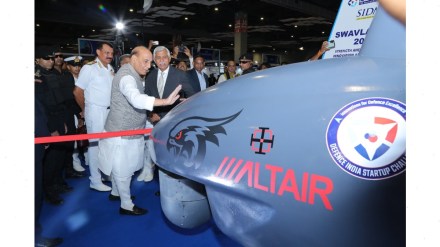India’s quest for a self-sustaining defence ecosystem reached a new milestone with the launch of the third edition of the Acing Development of Innovative Technologies with iDEX (ADITI 3.0) challenge and the 13th Defence India Start-up Challenges (DISC 13).
Defence Minister Rajnath Singh announced these initiatives at the Swavlamban 3.0 seminar hosted by the Naval Innovation and Indigenisation Organisation (NIIO) at Bharat Mandapam in New Delhi on October 29, 2024. Both ADITI 3.0 and DISC 13 signify a major push toward strengthening indigenous defence capabilities, inviting start-ups and MSMEs to develop high-impact technologies for the Indian Armed Forces.
Catalyzing Innovation: ADITI 3.0 and DISC 13
ADITI 3.0, a flagship program, introduces a significant new challenge from the Indian Navy to develop a High-Power Microwave Weapon System, demonstrating India’s commitment to next generation defence capabilities. Meanwhile, DISC 13 presents seven specific challenges across critical domains such as Artificial Intelligence, military communication, and autonomous systems. With three challenges from the Indian Army and two each from the Navy and Air Force, DISC 13 aims to harness cutting-edge innovation that strengthens the nation’s defence sector.
The minister also celebrated the achievements of innovators and start-ups involved in previous rounds, emphasizing the government’s commitment to support domestic talent in defence technology. “Our innovators must not only address current needs but envision solutions that could become indispensable for our Armed Forces,” Singh asserted, encouraging a forward-looking approach in the defence sector.
A Surge of Domestic Proposals Under SPRINT Challenges
Singh highlighted the impressive response to SPRINT (Supporting Pole-Vaulting in R&D through iDEX, Naval Innovation, and Technology Development Acceleration Cell), launched by Prime Minister Modi during Swavlamban 1.0 in 2022. The Indian Navy has since received over 2,000 proposals from Indian industries, resulting in 155 challenges. These initiatives have culminated in 171 contracts that propel technological advancement across multiple defence applications. Through Swavlamban’s collaboration with over 213 MSMEs and start-ups under the Innovations for Defence Excellence (iDEX) initiative, Acceptance of Necessity (AoN) for projects worth over Rs 2,000 crore has been granted, with contracts totaling Rs 784 crore already completed.
Fostering an ‘Innovative Navy’ and Broader Defence Self-Reliance
Underlining the Indian Navy’s strategic vision, Chief of the Naval Staff Admiral Dinesh K Tripathi reinforced its commitment to becoming a “Fully Aatmanirbhar Force” by 2047. He noted that 173 Navy-led challenges—including the 75 challenges launched during the ‘Azadi Ka Amrit Mahotsav’—have yielded tangible solutions that enhance India’s defence capabilities. He added, “This year’s expanded edition introduces new transformational technology challenges and Hackathons, setting a record in participation from all defence sectors.”
The Chief’s vision for a self-reliant Navy was matched by the Defence Minister’s acknowledgment of the collaborative efforts of both public and private sectors in realizing this goal. Singh expressed satisfaction with the performance of Defence Public Sector Undertakings (DPSUs) and stressed the importance of continuous innovation. Hindustan Aeronautics Limited (HAL) recently achieving ‘Maharatna’ status is a testament to the strides made by DPSUs in strengthening India’s defence ecosystem.
The Growing Role of Start-Ups in Defence Manufacturing
With India now home to over one lakh start-ups, including more than 100 unicorns, the minister stressed their role in defence manufacturing. The Government’s sustained push for a self-reliant India has fueled a rise in youth-led start-ups focused on defence technology. Singh praised these entrepreneurs, noting their significant contribution to making India self-sufficient through innovation. He affirmed that the government would continue to support these initiatives, ensuring that the start-up ecosystem remains integral to India’s defence sector.
Sagarmala Parikrama and New Partnerships in Technology Development
In another landmark initiative, Swavlamban 3.0 saw the flag-off of the ‘Sagarmala Parikrama’—a 1,500 km autonomous journey from Mumbai to Tuticorin. This mission demonstrates India’s advancements in autonomous maritime technology, furthering the government’s goal of promoting indigenous innovation in defence.
To support niche technologies like semiconductors, Bharat Electronics Limited (BEL) signed an MoU with 3rdiTech and Bharat Semiconductors during the event. This collaboration aligns with the government’s vision to develop manufacturing capabilities in critical sectors, which is crucial to India’s defence self-reliance ambitions.
Building a Culture of Innovation in India’s Defence Ecosystem
Singh stressed that self-reliance, science, and technology have now become revolutionary ideals in India, backed by the government’s efforts to create an innovative culture across industries. “Our dependence on imports once stifled domestic innovation, but the visionary policies of Prime Minister Narendra Modi have rapidly transformed this landscape,” he remarked.
